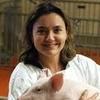Effect of sow vaccination on the detection of influenza A virus in pigs at weaning
Published: October 14, 2024
Source : F. Chamba 1, M. Allerson 2, M. Culhane 1, P. Davies 1, R. Morrison 1, A. Perez 1, M. Torremorell 1 / 1 Veterinary Population Medicine Department, University of Minnesota, St. Paul, MN; 2 Holden Farms Inc., Northfield, MN, United States.
Summary
Keywords: Influenza A Virus, sow vaccination, weaning pigs
Introduction:
Most common influenza A virus (IAV) control measures include sow vaccination using prefarrow, mass or a combination of prefarrow and mass vaccination protocols with either commercial, autogenous or both vaccines. Piglets prior to wean are important in the maintenance of influenza infections in breeding herds as well as in the dissemination of the virus into wean-to-finish facilities. The aim of this study was to evaluate the effect of sow vaccination protocol and type of vaccine used on the detection of IAV in groups of pigs at weaning.
Materials and Methods:
There were 52 farms enrolled which were located in 6 U.S. states. Thirty nasal swabs were collected monthly for 6 months in each farm from pigs prior to wean. Sampling timeframe was between January and November 2013. One piglet was conveniently selected from each of 30 litters and nasal swabs collected. Swabs were tested in pools of 3 to detect influenza matrix gene by RT-PCR at the UMN-VDL.
Generalized linear mixed logistic (GLMM) regression models were used with influenza RT-PCR results (positive/negative) at group level as the outcome, and vaccination protocol and type of vaccine as fixed predictors within univariable models. Farm and season (time) were incorporated as random predictors.
Results:
Sixty three percent of herds vaccinated against IAV. Out of the 33 herds that vaccinated, 45%, 36% and 19% had prefarrow, mass and prefarrow and mass vaccination protocols, respectively. Out of 32 vaccinated farms, 53%, 31% and 16% used commercial, autogenous or a combination of commercial and autogenous vaccines, respectively. One production system did not report the type of vaccine used and was excluded from the analysis. Overall, 48% of the herds tested positive and of these, 44% of vaccinated and 58% of non-vaccinated herds tested positive at least once. Moreover, 25% of groups of pigs at weaning tested positive with vaccinated herds having 16% of positive groups compared to 40% of the non-vaccinated herds.
The odds of detecting positive groups significantly decreased by 84% in vaccinated herds. Prefarrow and mass vaccination protocols significantly decreased the odds of positive groups compared to no vaccination. There were no significant differences between prefarrow and mass vaccination protocols. Commercial vaccines significantly decreased the odds of having positive groups of pigs at weaning compared to no vaccination, and a similar trend was observed for autogenous vaccines. There were no significant differences between commercial and autogenous vaccines.
Conclusion:
Overall, our results indicated that IAV sow vaccination may be an effective tool at reducing the prevalence of IAV in piglets at weaning.
Disclosure of Interest: None Declared.
Published in the proceedings of the International Pig Veterinary Society Congress – IPVS2016. For information on the event, past and future editions, check out https://www.theipvs.com/future-congresses/.
Content from the event:
Related topics:
Mentioned in this news release:



Recommend
Comment
Share

Would you like to discuss another topic? Create a new post to engage with experts in the community.












